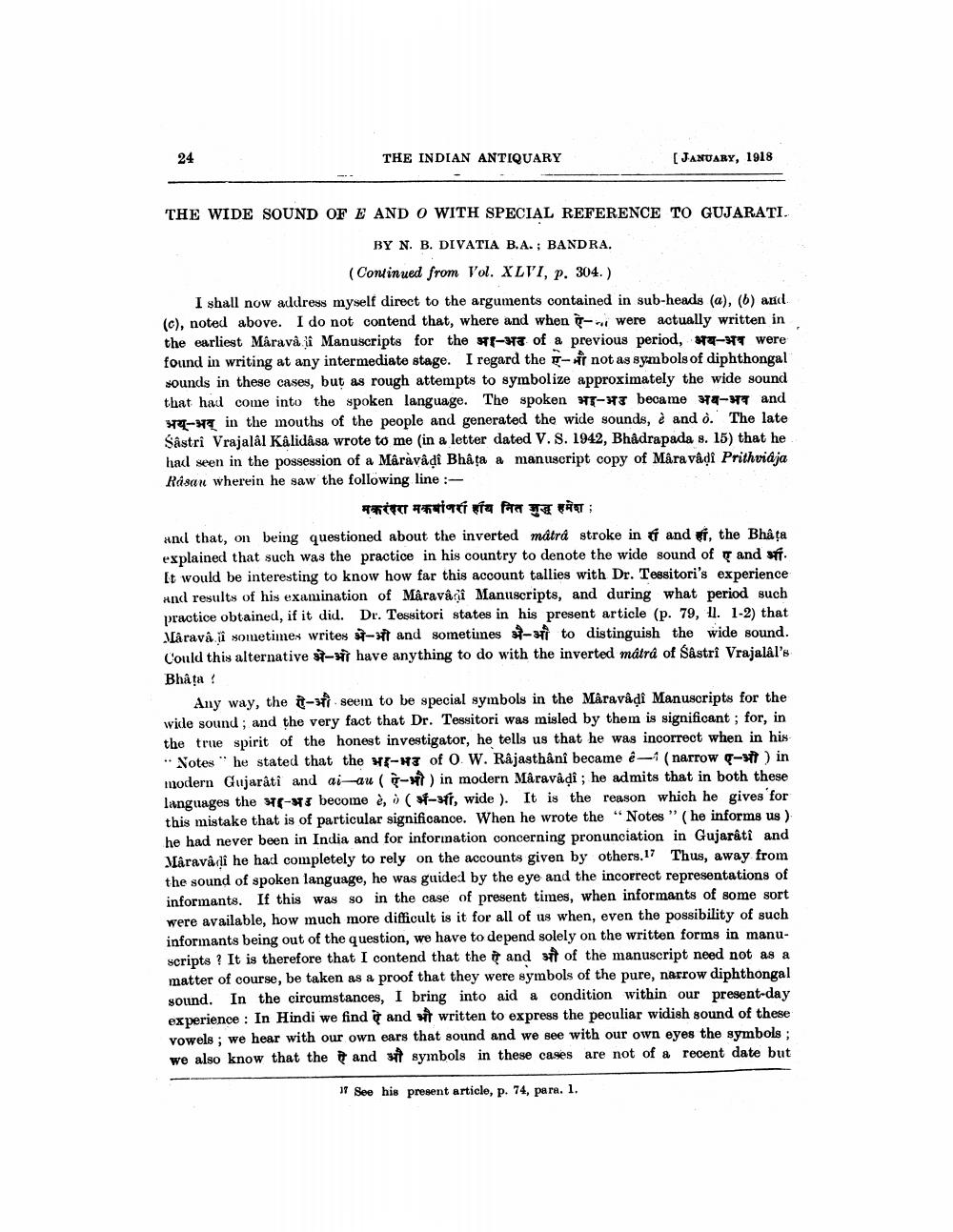________________
24
THE INDIAN ANTIQUARY
[ JANUARY, 1918
THE WIDE SOUND OF E AND O WITH SPECIAL REFERENCE TO GUJARATI.
BY N. B. DIVATIA B.A.; BANDRA.
(Continued from Vol. XLVI, P. 304.) I shall now address myself direct to the arguments contained in sub-heads (a), (b) and (c), noted above. I do not contend that, where and when were actually written in the earliest Maravà i Manuscripts for the -H7 of a previous period, 12-17 were found in writing at any intermediate stage. I regard the - not as symbols of diphthongal sounds in these cases, but as rough attempts to symbolize approximately the wide sound that had come into the spoken language. The spoken भइ-अउ became अब-भव and 174-in the mouths of the people and generated the wide sounds, è and ò. The late Sastri Vrajalâl Kalidasa wrote to me (in a letter dated V. S. 1942, Bhadrapada s. 15) that he had seen in the possession of a Mâravadi Bhâta a manuscript copy of Måra vadi Prithvidja Rasan wherein he saw the following line :
Ha Hoi da fa 4 và and that, on being questioned about the inverted mátra stroke in and of the Bhâţa explained that such was the practice in his country to denote the wide sound of T and af It would be interesting to know how far this account tallies with Dr. Tessitori's experience and results of his examination of Maravà i Manuscripts, and during what period such practice obtained, if it did. Dr. Tessitori states in his present article (p. 79, l. 1-2) that Mårava i sometimes writes - and sometimes s i to distinguish the wide sound. Could this alternative st have anything to do with the inverted mátra of Sastri Vrajalâl's Bha ta ?
Any way, the 1-3 seem to be special symbols in the Mâra vâdi Manuscripts for the wide sound; and the very fact that Dr. Tessitori was misled by them is significant ; for, in the true spirit of the honest investigator, he tells us that he was incorrect when in his * Notes" he stated that the HI-H7 of 0 W. Rajasthånî became é_1 (narrow -st) in modern Gujarati and ai-au (9-4) in modern Mâravadi; he admits that in both these languages the 6-8 become è, • (-37, wide ). It is the reason which he gives for this mistake that is of particular significance. When he wrote the “Notes "(he informs us ) he had never been in India and for information concerning pronunciation in Gujarati and Mâravâdi he had completely to rely on the accounts given by others.17 Thus, away from the sound of spoken language, he was guided by the eye and the incorrect representations of informants. If this was so in the case of present times, when informants of some sort were available, how much more difficult is it for all of us when, even the possibility of such informants being out of the question, we have to depend solely on the written forms in manuscripts? It is therefore that I contend that the t and sit of the manuscript need not as a matter of course, be taken as a proof that they were symbols of the pure, narrow diphthongal sound. In the circumstances, I bring into aid a condition within our present-day experience : In Hindi we find and wit written to express the peculiar widish sound of these vowels; we hear with our own ears that sound and we see with our own eyes the symbols ; we also know that the and w symbols in these cases are not of a recent date but
IT See his present article, p. 74, para. 1.




